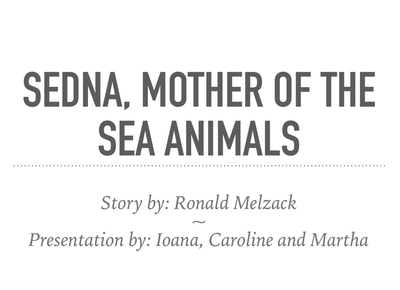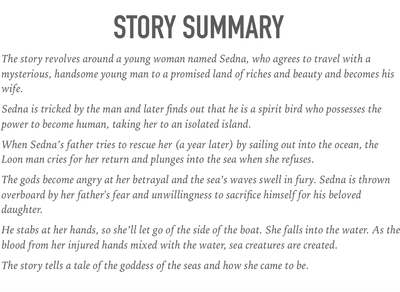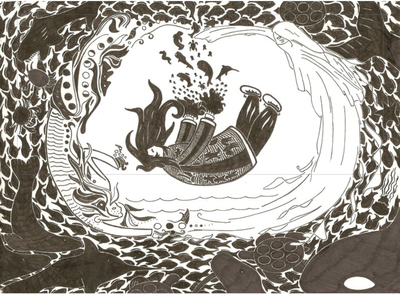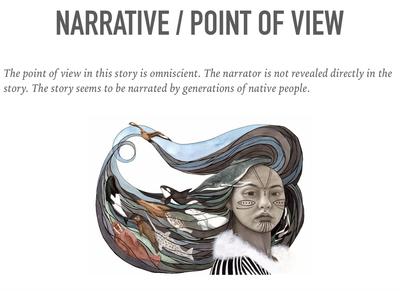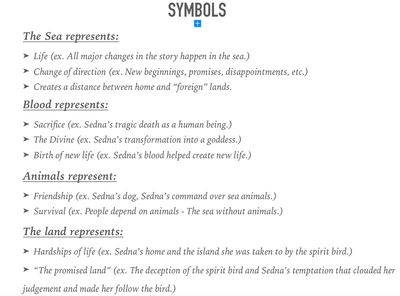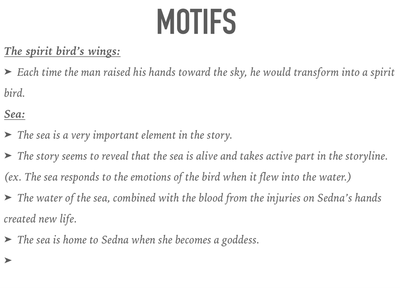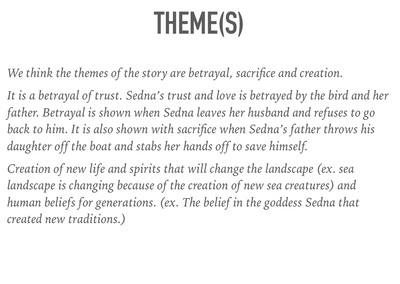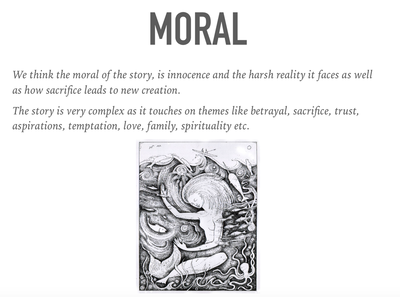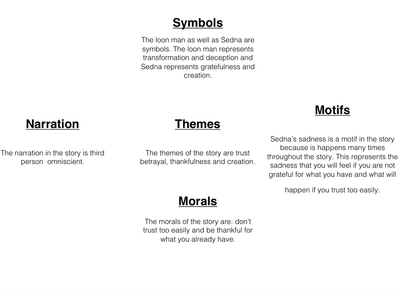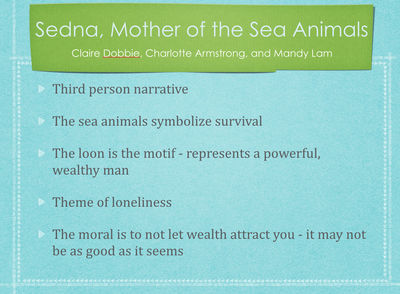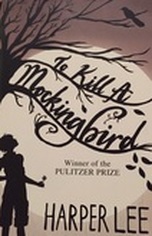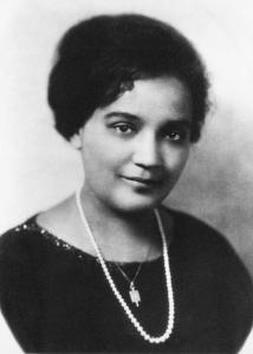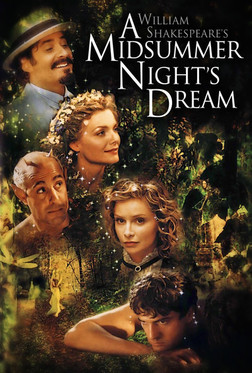Creation Stories
"Great Spirit Help Me Always To Speak The Truth Quietly,
To Listen With An Open Mind When Others Speak, And
To Remember The Peace That May Be Found In Silence."
First Nations Proverb.
"Great Spirit Help Me Always To Speak The Truth Quietly,
To Listen With An Open Mind When Others Speak, And
To Remember The Peace That May Be Found In Silence."
First Nations Proverb.
The 4 creation stories that we read were:
The Raven Steals The Light - Robert Bringhurst (Native Canadian - Haida)
The Woman Who Fell From The Sky - By Ella Elizabeth Clark (Native Canadian - Huron)
Sedna, Mother Of The Sea Animals - Ronald Melzack (Native Canadian - Inuit)
Nanabush Creates The World - David Coatsworth (Native Canadian - Ojibwa)
Some of the morals that we found were as follows:
"Be kind and share."
"You don't know what you truly have."
"Two wrongs don't make a right."
"Be happy with what you have."
"Don't keep beauty for yourself."
Our Class Master Morals:
The Woman Who Fell From the Sky - By Ella Elizabeth Clarke
" Do Good And Good Things Will Happen."
"Good will overcome evil"
"Life is precious, don't take life for granted"
"Dont take life for granted"
Nanabush Creates The World - Ronald Melzack
"Never Give Up On Your Goals Because They Will Happen."
"Sacrifices are needed to make up right or wrong"
Sedna, Mother Of the Animals - David Coatsworth
"Always Be Grateful For What You Have."
"Never give up, even when you loose hope"
"Good things can come out of any bad"
"Be kind and share."
"You don't know what you truly have."
"Two wrongs don't make a right."
"Be happy with what you have."
"Don't keep beauty for yourself."
Our Class Master Morals:
The Woman Who Fell From the Sky - By Ella Elizabeth Clarke
" Do Good And Good Things Will Happen."
"Good will overcome evil"
"Life is precious, don't take life for granted"
"Dont take life for granted"
Nanabush Creates The World - Ronald Melzack
"Never Give Up On Your Goals Because They Will Happen."
"Sacrifices are needed to make up right or wrong"
Sedna, Mother Of the Animals - David Coatsworth
"Always Be Grateful For What You Have."
"Never give up, even when you loose hope"
"Good things can come out of any bad"
Our community of learning collected First Nations Images. Here is our image gallery.
Summary Slides
Below are some examples of the summary slides that you and your fellow students created:
Below are some examples of the summary slides that you and your fellow students created:
To Kill A Mocking Bird - By Harper Lee
"If We Have No Peace, It Is Because We Have Forgotton That We Belong To Each Other." - Mother Teresa
Historical Background - Harlem Renaissance
The Harlem Renaissance was the name given to the cultural, social, and artistic explosion that took place in Harlem between the end of World War I and the middle of the 1930s. During this period Harlem was a cultural center, drawing black writers, artists, musicians, photographers, poets, and scholars. Many had come from the South, fleeing its oppressive caste system in order to find a place where they could freely express their talents.
|
|
|
|
|
|
"You never really understand a person until you consider things from his point of view . .
until you climb into his skin and walk around in it." (Chapter 3)
|
Please read the background information about Jessie Redmont Fauset
Jessie Redmon Fauset (1882 – 1961) Fauset’s influence within the Harlem Renaissance cannot be overstated. As the literary editor of The Crisis (or Crisis) — the official magazine of the NAACP, founded by W. E. B. Du Bois — she led the development of many of its key ideas, and also the careers of its writers, including Langston Hughes and Nella Larsen. Fauset was the first black woman accepted to Phi Beta Kappa, and the first black woman graduate from Cornell. Her novels, including There is Confusion — considered the first Harlem novel — are said to rank with the work of Nella Larsen and Zora Neale Hurston, according to The Encyclopedia of the Harlem Renaissance. |
Prose To Poetry Task
You will select one of the following passages
underline or highlight all of the words that stand - out to you, essentially these will be some or if not all of the descriptive words
You are then challenged to create a poem using the figurative elements:
Here are the 2 selected passages. Please note that if you find a passage in the text that you would like to use, please let me know, thank you.
"Maycomb was an old town, but it was a tired old town when I first knew it. In rainy weather the streets turned to red slop . . . [s]omehow it was hotter then . . . bony mules hitched to Hoover carts flicked flies in the sweltering shade of the live oaks on the square. Men’s stiff collars wilted by nine in the morning. Ladies bathed before noon, after their three-o’clock naps, and by nightfall were like soft teacakes with frostings of sweat and sweet talcum. . . . There was no hurry, for there was nowhere to go, nothing to buy and no money to buy it with, nothing to see outside the boundaries of Maycomb County. But it was a time of vague optimism for some of the people: Maycomb County had recently been told that it had nothing to fear but fear itself." Chapter 1
"A boy trudged down the sidewalk dragging a fishing pole behind him. A man stood waiting with his hands on his hips. Summertime, and his children played in the front yard with their friend, enacting a strange little drama of their own invention. It was fall, and his children fought on the sidewalk in front of Mrs. Dubose’s. . . . Fall, and his children trotted to and fro around the corner, the day’s woes and triumphs on their faces. They stopped at an oak tree, delighted, puzzled, apprehensive. Winter, and his children shivered at the front gate, silhouetted against a blazing house. Winter, and a man walked into the street, dropped his glasses, and shot a dog. Summer, and he watched his children’s heart break. Autumn again, and Boo’s children needed him. Atticus was right. One time he said you never really know a man until you stand in his shoes and walk around in them. Just standing on the Radley porch was enough." Chapter 31
You will select one of the following passages
underline or highlight all of the words that stand - out to you, essentially these will be some or if not all of the descriptive words
You are then challenged to create a poem using the figurative elements:
- Title
- Open form
- Closed form
- Simile
- Metaphor
- You will begin this task in class, and then complete this for homework
- Please have this ready for next class
- You will receive feed forward (feedback) for this task
Here are the 2 selected passages. Please note that if you find a passage in the text that you would like to use, please let me know, thank you.
"Maycomb was an old town, but it was a tired old town when I first knew it. In rainy weather the streets turned to red slop . . . [s]omehow it was hotter then . . . bony mules hitched to Hoover carts flicked flies in the sweltering shade of the live oaks on the square. Men’s stiff collars wilted by nine in the morning. Ladies bathed before noon, after their three-o’clock naps, and by nightfall were like soft teacakes with frostings of sweat and sweet talcum. . . . There was no hurry, for there was nowhere to go, nothing to buy and no money to buy it with, nothing to see outside the boundaries of Maycomb County. But it was a time of vague optimism for some of the people: Maycomb County had recently been told that it had nothing to fear but fear itself." Chapter 1
"A boy trudged down the sidewalk dragging a fishing pole behind him. A man stood waiting with his hands on his hips. Summertime, and his children played in the front yard with their friend, enacting a strange little drama of their own invention. It was fall, and his children fought on the sidewalk in front of Mrs. Dubose’s. . . . Fall, and his children trotted to and fro around the corner, the day’s woes and triumphs on their faces. They stopped at an oak tree, delighted, puzzled, apprehensive. Winter, and his children shivered at the front gate, silhouetted against a blazing house. Winter, and a man walked into the street, dropped his glasses, and shot a dog. Summer, and he watched his children’s heart break. Autumn again, and Boo’s children needed him. Atticus was right. One time he said you never really know a man until you stand in his shoes and walk around in them. Just standing on the Radley porch was enough." Chapter 31
Our Poetry Gallery
This is a collection of the poetry that our students created through the Prose to Poetry task
Integrating Quotations
For this lesson we will learn how to integrate quotations into a paragraph. The teaching and learning in this lesson will help to prepare you for the work of essay writing. We will examine the Sonnet XVIII by Shakespeare to build our knowledge.
Sonnet XVIII Shall I compare thee to a summer's day?
Thou art more lovely and more temperate:
Rough winds do shake the darling buds of May,
And summer's lease hath all too short a date:
Sometime too hot the eye of heaven shines,
And often is his gold complexion dimmed,
And every fair from fair sometime declines,
By chance, or nature's changing course untrimmed:
But thy eternal summer shall not fade,
Nor lose possession of that fair thou ow'st,
Nor shall death brag thou wander'st in his shade,
When in eternal lines to time thou grow'st,
So long as men can breathe, or eyes can see,
So long lives this, and this gives life to thee.
This is one of the most famous of all the sonnets, justifiably so. But it would be a mistake to take it entirely in isolation, for it links in with so many of the other sonnets through the themes of the descriptive power of verse; the ability of the poet to depict the fair youth adequately, or not; and the immortality conveyed through being hymned in these 'eternal lines'. It is noticeable that here the poet is full of confidence that his verse will live as long as there are people drawing breath upon the earth, whereas later he apologises for his poor wit and his humble lines which are inadequate to encompass all the youth's excellence. Now, perhaps in the early days of his love, there is no such self-doubt and the eternal summer of the youth is preserved forever in the poet's lines. The poem also works at a rather curious level of achieving its objective through dispraise. The summer's day is found to be lacking in so many respects (too short, too hot, too rough, sometimes too dingy), but curiously enough one is left with the abiding impression that 'the lovely boy' is in fact like a summer's day at its best, fair, warm, sunny, temperate, one of the darling buds of May, and that all his beauty has been wonderfully highlighted by the comparison.
Sonnet XVIII Shall I compare thee to a summer's day?
Thou art more lovely and more temperate:
Rough winds do shake the darling buds of May,
And summer's lease hath all too short a date:
Sometime too hot the eye of heaven shines,
And often is his gold complexion dimmed,
And every fair from fair sometime declines,
By chance, or nature's changing course untrimmed:
But thy eternal summer shall not fade,
Nor lose possession of that fair thou ow'st,
Nor shall death brag thou wander'st in his shade,
When in eternal lines to time thou grow'st,
So long as men can breathe, or eyes can see,
So long lives this, and this gives life to thee.
This is one of the most famous of all the sonnets, justifiably so. But it would be a mistake to take it entirely in isolation, for it links in with so many of the other sonnets through the themes of the descriptive power of verse; the ability of the poet to depict the fair youth adequately, or not; and the immortality conveyed through being hymned in these 'eternal lines'. It is noticeable that here the poet is full of confidence that his verse will live as long as there are people drawing breath upon the earth, whereas later he apologises for his poor wit and his humble lines which are inadequate to encompass all the youth's excellence. Now, perhaps in the early days of his love, there is no such self-doubt and the eternal summer of the youth is preserved forever in the poet's lines. The poem also works at a rather curious level of achieving its objective through dispraise. The summer's day is found to be lacking in so many respects (too short, too hot, too rough, sometimes too dingy), but curiously enough one is left with the abiding impression that 'the lovely boy' is in fact like a summer's day at its best, fair, warm, sunny, temperate, one of the darling buds of May, and that all his beauty has been wonderfully highlighted by the comparison.
Task
Select a passage from the novel: To Kill A Mocking Bird
Use the handout and the worksheet to create example of the following elements
Please create 1 example per item
Select a passage from the novel: To Kill A Mocking Bird
Use the handout and the worksheet to create example of the following elements
Please create 1 example per item
- A short quotation
- A long quotation
- Ellipsis
- Slash
- Quotation Marks
- Line Numbers
- Authors Name
- How to introduce a quote
A Midsummer Night's Dream
Shakespeare's Language
Shakespearean Rhythm Hand - Out
Shakespeare uses many different form of rhythm and prose. Please review the hand - out that we discussed in class.
An iamb consists of one unstressed and one stressed syllable. If a line consists of 5 iamb's it is known as Iambic Pentameter. Please watch the following You - Tube clip to further our understanding
Shakespeare uses many different form of rhythm and prose. Please review the hand - out that we discussed in class.
An iamb consists of one unstressed and one stressed syllable. If a line consists of 5 iamb's it is known as Iambic Pentameter. Please watch the following You - Tube clip to further our understanding
What is a Soliloquy?
A Soliloquy is a dramatic or literary form of discourse in which a character talks to himself or herself. The character will reveal his / her thoughts when alone or unaware of the presence of other characters. It is a specific speech or piece of writing in the form of speaking to oneself. This is a theatrical device. It is different from a monologue.
Monologue - The speaker will be talking to different characters
Soliloquy - The speaker is always talking to himself or herself.
Act 2 Scene 1
|
|
Think about ..... The You Tube clip is an example of Act 2 Scene 1 from William Shakespeare's : A Midsummer Night's Dream. Please watch this, pay attention to the characters and how they are interacting with the stage, their movements, facial expressions, tone of voice. Think about how all of these items contribute to, and convey meaning to the play. |
Review Questions Hand - out
Our Review Questions for Act 2, Scene 1
Part 1 Line 1 - 59
Explain why Oberon is full of jealousy and anger towards his wife?
Titania has a new child, The child is the center of attention
They are always fighting
Relate at least two of the practical jokes that Robin Goodfellow is famous for?
Robin Good Fellow is Puck Jokes - Misleads drunks moving around Makes drinks with no barm (Froth)
Part 2 Line 60 - 147
When Oberon and Tatiana meet, what do they accuse each other of doing?
Cheating on each other
Titania points out to Oberon that their fighting has distracted all of nature. Relate these problems in nature that she feels have been brought about by their debate?
Droughts Floods Sea is being sucked up The imagery shows the intensity and depth of the disturbance that she feels.
Part 3 Line 148 - 268
After Puck has gone, what does Oberon reveal in his Soliloquy?
Watch Tatiana sleep Pours liquor into his eyes
Quote lines that show Helena is extremely lovesick
"And I am sick when I look not on you" - (L 213)
Act 2, Scene 2
What is a subtext?
A sub - text is the less obvious meaning or message that is derived from speech.
Example:
"I'm glad you're here this evening"
What is the meaning of this sentence depending on which word is emphasized?
Group reading task
Form groups to read scene 2 together, please answer and discuss the study questions.
Act II, scene ii
1. Why do Lysander and Hermia argue about how they will lie down to rest in the woods? Who wins the argument?
2. What is ironic in the lines, “Pretty soul, she durst not lie / Near this lack-love, this kill-courtesy”?
3. After awakening, Lysander gives reasons to explain his sudden love for Helena. In your own words, give two of his explanations for this sudden passion.
4. Hermia awakens alone, terrified by a nightmare she has had. In her soliloquy, what does she say that she will do?
Sub - text task
We will read Act 2, Scene 2. 41-71
Students will play the role of Hermia and Lysander, let's suggest various sub - texts for this scene.
Please complete the Dance of the Lovers hand - out for this scene.
Next Class - There will be a review test for Act 2
What is a subtext?
A sub - text is the less obvious meaning or message that is derived from speech.
Example:
"I'm glad you're here this evening"
What is the meaning of this sentence depending on which word is emphasized?
Group reading task
Form groups to read scene 2 together, please answer and discuss the study questions.
Act II, scene ii
1. Why do Lysander and Hermia argue about how they will lie down to rest in the woods? Who wins the argument?
2. What is ironic in the lines, “Pretty soul, she durst not lie / Near this lack-love, this kill-courtesy”?
3. After awakening, Lysander gives reasons to explain his sudden love for Helena. In your own words, give two of his explanations for this sudden passion.
4. Hermia awakens alone, terrified by a nightmare she has had. In her soliloquy, what does she say that she will do?
Sub - text task
We will read Act 2, Scene 2. 41-71
Students will play the role of Hermia and Lysander, let's suggest various sub - texts for this scene.
Please complete the Dance of the Lovers hand - out for this scene.
Next Class - There will be a review test for Act 2
Act 3, Scene 1
We will read Act 3, Scene 1 in 3 parts.
Line 1-58
Line 59-98
Lines 99-178
We will read Act 3, Scene 1 in 3 parts.
Line 1-58
Line 59-98
Lines 99-178
Act 3, Scene 2
We will watch Act 3. 1-2 from the Oxford Next Website After we have watched the scenes take out your charting booklets and add details to the character study charts.
Bio - poem Practice
Bio - poem Activity. This activity is to help prepare you for a later task
Please complete the Bio-poem hand out.
On a sheet of chart paper we will now write a Bio - poem for one of the character's in this scene.
Here is an example - Bio - poem for Puck
We will watch Act 3. 1-2 from the Oxford Next Website After we have watched the scenes take out your charting booklets and add details to the character study charts.
Bio - poem Practice
Bio - poem Activity. This activity is to help prepare you for a later task
Please complete the Bio-poem hand out.
On a sheet of chart paper we will now write a Bio - poem for one of the character's in this scene.
Here is an example - Bio - poem for Puck
